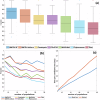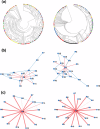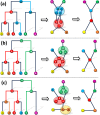A graph homomorphism approach for unraveling histories of metastatic cancers and viral outbreaks under evolutionary constraints
- PMID: 40877260
- PMCID: PMC12394457
- DOI: 10.1038/s41467-025-63411-4
A graph homomorphism approach for unraveling histories of metastatic cancers and viral outbreaks under evolutionary constraints
Abstract
Viral infections and cancers are driven by evolution of populations of highly mutable genomic variants. A key evolutionary process in these populations is their migration or spread via transmission or metastasis. Understanding this process is crucial for research, clinical practice, and public health, yet tracing spread pathways is challenging. Phylogenetics offers the main methodological framework for this problem, with challenges including determining the conditions when a phylogenetic tree reflects the underlying migration tree structure, and balancing computational efficiency, flexibility, and biological realism. We tackle these challenges using the powerful machinery of graph homomorphisms, a mathematical concept describing how one graph can be mapped onto another while preserving its structure. We focus on metastatic migrations and viral host-to-host transmissions in outbreak settings. We investigate how structural constraints on migration patterns influence the relationship between phylogenetic and migration trees and propose algorithms to evaluate trees consistency under varying conditions. Leveraging our findings, we introduce a framework for inferring transmission/migration trees by sampling potential solutions from a prior random tree distribution and identifying a subsample consistent with a given phylogeny. By varying the prior distribution, this approach generalizes several existing models, offering a versatile strategy applicable in diverse settings.
© 2025. The Author(s).
Conflict of interest statement
Competing interests: The authors declare no competing interests.
Figures







Similar articles
-
Prescription of Controlled Substances: Benefits and Risks.2025 Jul 6. In: StatPearls [Internet]. Treasure Island (FL): StatPearls Publishing; 2025 Jan–. 2025 Jul 6. In: StatPearls [Internet]. Treasure Island (FL): StatPearls Publishing; 2025 Jan–. PMID: 30726003 Free Books & Documents.
-
Healthcare workers' informal uses of mobile phones and other mobile devices to support their work: a qualitative evidence synthesis.Cochrane Database Syst Rev. 2024 Aug 27;8(8):CD015705. doi: 10.1002/14651858.CD015705.pub2. Cochrane Database Syst Rev. 2024. PMID: 39189465 Free PMC article.
-
Plug-and-play use of tree-based methods: consequences for clinical prediction modeling.J Clin Epidemiol. 2025 Aug;184:111834. doi: 10.1016/j.jclinepi.2025.111834. Epub 2025 May 19. J Clin Epidemiol. 2025. PMID: 40398688
-
ScITree: Scalable Bayesian inference of transmission tree from epidemiological and genomic data.PLoS Comput Biol. 2025 Jun 10;21(6):e1012657. doi: 10.1371/journal.pcbi.1012657. eCollection 2025 Jun. PLoS Comput Biol. 2025. PMID: 40493703 Free PMC article.
-
Fabricating mice and dementia: opening up relations in multi-species research.In: Jenkins N, Jack-Waugh A, Ritchie L, editors. Multi-Species Dementia Studies. Bristol (UK): Bristol University Press; 2025 Feb 25. Chapter 2. In: Jenkins N, Jack-Waugh A, Ritchie L, editors. Multi-Species Dementia Studies. Bristol (UK): Bristol University Press; 2025 Feb 25. Chapter 2. PMID: 40690569 Free Books & Documents. Review.
References
-
- DeGregori, J. Adaptive Oncogenesis: A New Understanding of How Cancer Evolves Inside Us. (Harvard University Press, Cambridge, MA, 2018).
-
- Nowell, P. C. The clonal evolution of tumor cell populations: Acquired genetic lability permits stepwise selection of variant sublines and underlies tumor progression. Science194, 23–28 (1976). - PubMed
MeSH terms
Grants and funding
LinkOut - more resources
Full Text Sources
Medical

